A prototype of a high-speed Sikorsky S-97 Raider helicopter is shown.
The high-speed S-97 helicopter is being developed based on the experience gained by Sikorsky specialists during the X2 project. The main objective of the new project is to create a helicopter capable of flying at a speed of at least 350-400 km / h. Due to some features of the aerodynamics of blades, modern helicopters cannot fly at such speeds. The S-97 project is designed to solve this problem, as well as to give the armed forces of the United States and other countries helicopters with high performance.
It should be noted that the Sikorsky S-97 Raider, for some reasons, does not fully comply with the definition of “helicopter”. A similar technique, created recently, is denoted by the terms "high-speed helicopter" and "rotorcraft". However, a new class aviation technology is only just being formed, which is why the generally accepted term for its designation has not yet been defined. In the materials of the Sikorsky company, the new development is called a helicopter. So we will call her.
The S-97 project is the first development of the Sikorsky company in this area, created with consideration of real use. New high-speed helicopters are supposed to be offered to the US military, where they will be able to replace reconnaissance helicopters OH-58 Kiowa Warrior. The new equipment will be able to carry out reconnaissance flights, deliver soldiers to specified areas, as well as support ground units with fire. Thus, the company Sikorsky actually created a new multifunctional military helicopter.
The first combat helicopter of the new scheme turned out to be relatively small and light. The total length of the machine does not exceed 11 m, the maximum span of the planes (stabilizer) is equal to 4,87 m, and the diameter of the coaxial bearing screws is 10,4 m. The declared take-off weight of the machine does not exceed 5 tons. It is alleged that with such dimensions and weight the helicopter S-97 Raider will be able to perform a wide range of different tasks.
The new helicopter has a streamlined fuselage. In the nose of the fuselage is a double cabin with the location of the two pilots side by side. The cabin is equipped with two side doors for landing pilots. A cargo / passenger cabin is provided in the middle part of the fuselage. According to the developers, the helicopter will be able to carry up to six paratroopers or an equivalent amount of cargo, for example, a stock of fuel and weapons.
Above the cabin is a turboshaft engine and a main gearbox. The latter distributes the engine power to the coaxial rotors and the pusher tail propeller. The tail screw is one of the main features of the project, affecting the entire technical appearance of the machine. It is the tail rotor that should provide high flight speed.
To accommodate weapons in the middle part of the fuselage there is a small wing with two arms suspension points. To control the flight at high speeds in the tail of the machine there is a stabilizer with a rudder with keels at the ends, as well as an extra ventral carina. The latter accommodates the tail wheel of the landing gear, retractable in flight. The main landing gear located in the nose of the fuselage behind the cockpit and are removed in flight.
The Sikorsky S-97 Raider helicopter is equipped with coaxial rotors of the original design. The main problem preventing helicopters from developing high speeds is the specific flow around the blades. Upon reaching a certain flight speed, the speed of movement of the tip of the blade relative to the air flow exceeds the speed of sound, which leads to disruption of the flow and loss of lift. The principles of helicopter flight are such that this phenomenon cannot be completely excluded, but it is possible to “transfer” its onset to higher speeds. For this, various methods and technologies can be applied.
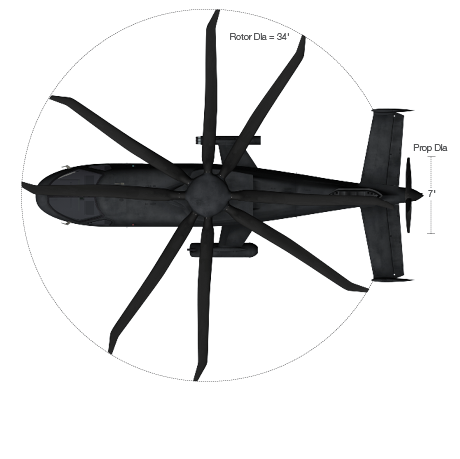
Engineers of the Sikorsky company, after analyzing the data collected during the tests of the experimental helicopter X2, developed a list of know-how used in the S-97 project. To optimize the aerodynamics of rotors at high speeds, it was decided to increase the rigidity of the blades, as well as equip them with arrow-shaped tips, designed to work at higher speeds in comparison with the main part of the blade. Due to this, two four-bladed rotors can work effectively at relatively high speeds.
The need to improve the aerodynamics of the entire helicopter forced the designers to use the rotor hub curlers. The mechanisms of the skew automatons of both screws are closed with fairings of a characteristic complex shape. Between them placed additional fairing, in the form of a drop shape.
Takeoff and landing, as well as flight with low and medium speeds should be provided with rotors. All these stages of the flight are proposed to perform "in a helicopter". During the transition to high-speed flight, the task of ensuring the translational motion is completely assigned to the pushing screw located in the tail section. Used six-bladed propeller with variable pitch blades. Probably, when flying at speeds of more than 250-300 km / h, the lifting force should be provided not only with rotors, but also with planes: a developed stabilizer and a small wing. Control in high-speed flight is provided by the rudder on the stabilizer and the rudders on the keels.
On the two pylons of the S-97 helicopter, AGM-114 Hellfire guided missiles, blocks of unguided missiles and machine gun containers can be suspended. Such a combat load will provide a sufficiently high flexibility of the use of a helicopter to support ground units. Thus, the helicopter can perform not only transport or reconnaissance missions, but also some shock ones.
The know-how used is said to provide fairly high flight characteristics. When using the tail pusher propeller, the S-97 Raider can fly at speeds up to 220 knots (around 407 km / h). Flight range exceeds 600 km, the maximum flight duration - more than 160 minutes. In the future, a significant increase in flight range is possible due to the installation of outboard fuel tanks or an in-flight refueling system.
Sikorsky S-97 Raider high-speed helicopter was repeatedly demonstrated at various exhibitions in the form of a model. October 2 public for the first time showed a prototype machine to be used in the tests. The first flight of the helicopter with the tail number N971SK will take place in December of this year. In the foreseeable future, the construction of the second prototype will be completed, which will also participate in flight tests.
The company Sikorsky Aircraft has high hopes for a new project. Moreover, S-97 Raider is called the new generation of combat helicopters. For four years, the company, having joined forces with several related organizations, has created the world's first high-speed helicopter, which, after passing tests and fine-tuning, can be put into operation by the armed forces. The leadership of the aircraft company considers this a reason for pride and hopes for the successful completion of the project.
Indeed, the project S-97 Raider, at least, is of great interest. The designers of the Sikorsky company managed not only to develop several pilot projects, but also to use the knowledge gained in the development of equipment designed for real use. Recall that since the late sixties, American aircraft manufacturers are engaged in the issue of high-speed helicopters with coaxial rotors and an additional pushing / pulling propeller.
Back in the mid-seventies, Sikorsky built two prototypes of the S-69 aircraft, equipped with coaxial rotors and two turbojet engines. During the tests, the car developed speeds above 515 km / h. However, the experimental aircraft had several serious flaws, which caused the project to be stopped after testing the prototypes.
The Sikorsky firm achieved the greatest success in the field of high-speed helicopters at the end of the last decade. In August 2008, the first flight of an experimental helicopter X2, built according to the same scheme as the proposed army S-97. Using coaxial rotors and a pusher propeller, rotated by a single turboshaft engine, this helicopter could accelerate to 460 km / h. Tests of the Sikorsky X2 helicopter continued until the 2011 year, after which the project was closed, and all the company's forces were thrown to develop a new high-speed helicopter.
The project of high-speed helicopter Sikorsky S-97 Raider out of the design stage and is preparing to start testing. The first flight of the prototype of the new model should take place before the end of this year. Tests and fine-tuning of the helicopter will take some time, after which the US military will be offered a new model of aircraft. The exact future of the car may still be the subject of controversy. However, due to the small number of new technology projects, the S-97 Raider project has already entered history world aviation.
On the materials of the sites:
http://sikorsky.com/
http://i-mash.ru/
http://janes.com/
http://defenseworld.net/
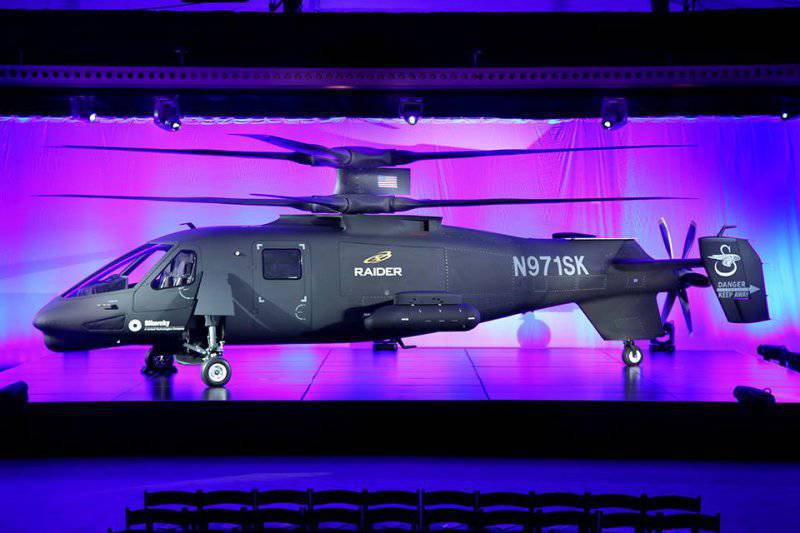
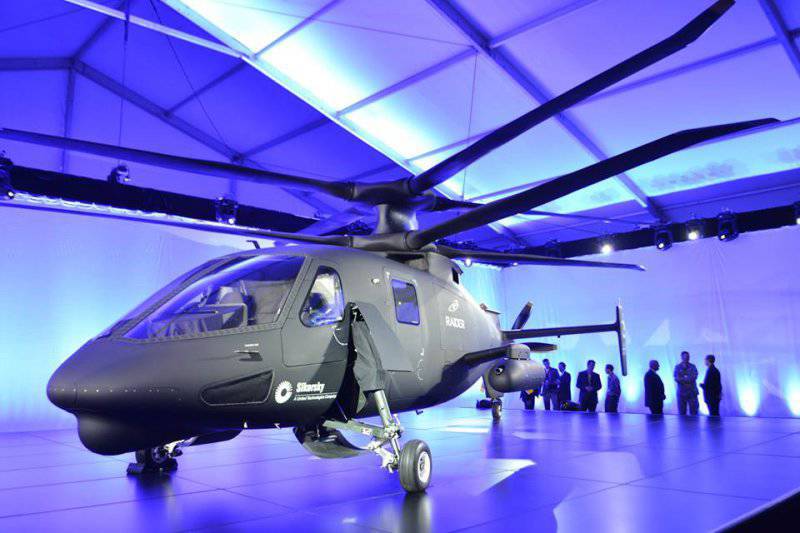
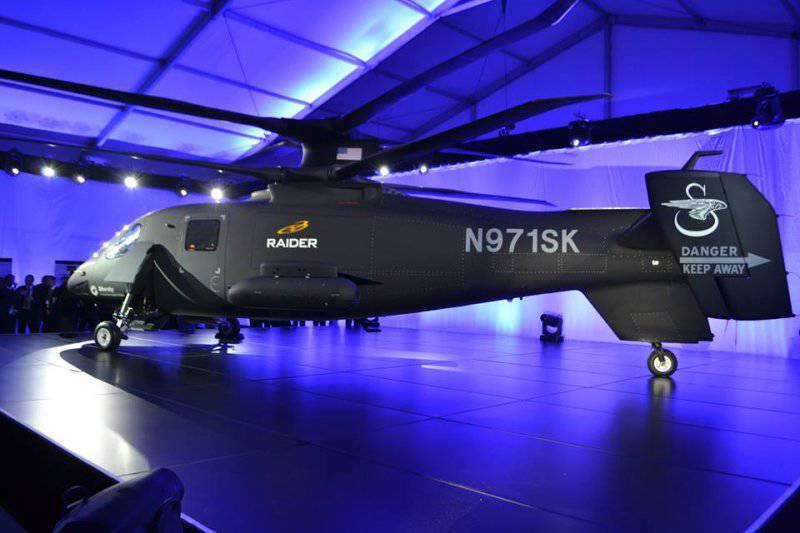
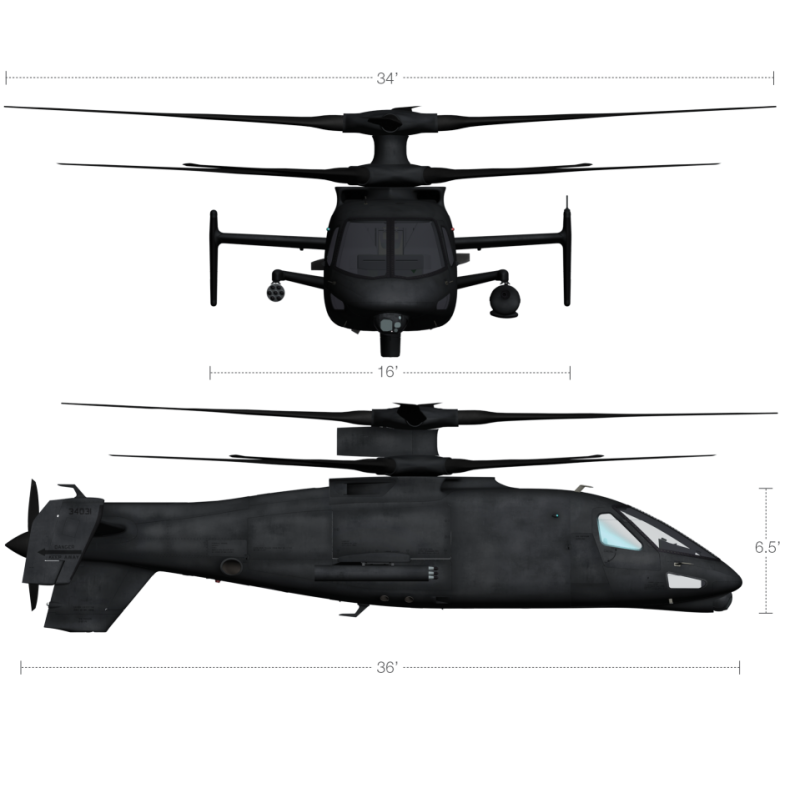
Information